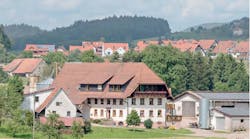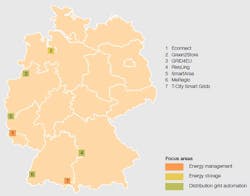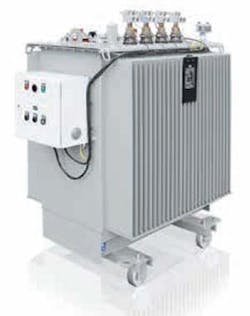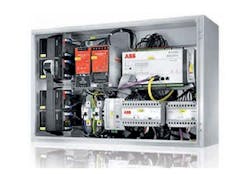The capacity of distribution feeders is defined by national or local grid codes and current practices of distribution system operators. However, several factors, such as thermal rating; voltage regulation; fault levels; power quality; reversal power flow and islanding; and protection schemes limit hosting capacity and many countries have proposed possible methods of overcoming this limitation [1]:
- Changing the topology of the grid, grid enforcement and/or new installations
- Short-circuit current as an ancillary service
- Voltage regulation and reactive power compensation
- Power control of distributed generators
- Adaptation of protection schemes
- Future options such as wide-area control, storage, load management and active elements
In Germany, the electricity system has been designed with high reserve capacities, meaning many grids can host additional generation. However, for most grids a limiting factor concerning grid capacity is voltage level. On top of this, fluctuations in wind speed and solar irradiation lead to fast voltage changes. Under these conditions, keeping the voltage within defined boundaries and avoiding flickers becomes quite a challenge. To stabilize voltage and provide reactive power from distributed generators, grid operators in Germany mainly consider two guidelines for compliance to their local grid code:
- The technical guideline from the German Association of Energy and Water Industries (BDEW) concerning the connection of plants to the medium-voltage network; the guideline is applicable to all generators with a capacity of 100 kW or higher [2].
- Compliance with the VDE networkconnecting regulation, VDE-AR-N 4105, is mandatory for all generators with an installed capacity below 100 kW [3].
The German Renewable Energy Act of 2012 requires all distributed generators with a capacity higher than 30 kW to participate in the feed-in management of the distribution system operator, who can then reduce active power by remote control in case of grid stability problems. In August 2014, the new Renewable Energy Act became effective, enhancing participation of distributed generation in the market and encouraging a reliable forecast of generation [4]. New European network codes prepared by the European Network of Transmission System Operators for Electricity (ENTSO-E) are currently in the process of becoming European law [5]. In its "Ancillary Services Study 2030" the German Energy Agency, dena, says that the very high penetration of distributed and renewable resources requires a new systemic approach for the development of the whole energy system over all voltage levels [6].
Pilot projects with grid operators and academia1 have resulted in innovative solutions from ABB to operate and control distribution grids with high shares of distributed generation in Germany. Some of these are described in the following sections ➔ 1.
Footnote
1 In partnership with grid operators such as RWE Deutschland AG, Westnetz, E.ON Mitte, STAWAG, Stadtwerke Duisburg, Netze BW and EnBW ODR, and academia such as TU Dortmund and Stuttgart University.
Tools to handle increasing complexity
In the past, it was easy to calculate load flows and voltage levels in a distribution system where power was distributed from higher to lower voltage levels. Nowadays, the grid collects and distributes energy at the same voltage level, making calculations more complex. To determine if a generator can be connected without violating limits, software tools are becoming more important for all voltage levels. One such tool, NEPLAN is being further developed so that planners can quickly react to requests from customers to connect their generators to the grid ➔ 2. This would help postpone or even avoid investments in grid extension by using the existing infrastructure to its maximum. However, as the infrastructure reaches its limits, asset reliability and availability become even more critical. In addition regulators are demanding flat maintenance spending despite grid extensions. Another tool, ABB's Asset Health Center, helps grid operators understand the risk of failure in each of their critical distribution assets, avoid asset failures and at the same time minimize their maintenance expenses.
The figure shows a low-voltage grid with a nominal voltage of 400 V. There is a substation in the upper-left corner. The background color visualizes the voltage range deviations in the grid. The green color represents areas where the voltage range is within the allowed voltage range. Considering a voltage range of eg, ±10 percent, the red color reflects areas which are below or above this value. Voltages below 360 V or above 440 V occur in areas which are far from the substation and have a high DER infeed and low load or in areas with no DER infeed and high load. The voltage deviation is due to a mismatch between production and consumption.
-------------------
Increasing grid capacity in Rhineland Palatinate
In 2011, RWE Deutschland AG demonstrated in an award-winning project how an active voltage regulator, the PCS100 AVR, based on ABB power electronics, could stabilize voltage levels in the 20 kV grid and at 20 kV / 0.4 kV transformer stations. By decoupling fluctuations at voltage levels of 110 kV, 20 kV and 0.4 kV, the capacity of the grid to host distributed generation was increased significantly, which in turn generated significant cost savings for the grid operator mainly at the 20 kV level. Between 2010 and 2013, ABB successfully implemented a total of 10 PCS100 AVRs in 20 kV / 0.4 kV transformer stations [7]. In fact the base product AVR is now well established on the market and is known for its very high power quality in industrial and commercial applications.
The project teams concluded that the typical requirements of a distribution system operator regarding voltage regulation at 110 kV / 20 kV and 20 kV / 0.4 kV transformer stations are lower than those of industrial applications and can be met with the more economical solution of an on-load tap changer. The Power Engineering Society of the German Association for Electrical, Electronic and Information Technologies e.V. (VDE-ETG) recommends distribution voltage regulation as an economically smart asset [8].
Based on these conclusions, ABB developed a voltage-controlled distribution transformer known as Smart-R Trafo 2 to match the requirements of distribution system operators ➔ 3. It is based on an economic on-load tap changer that changes voltage in five steps and provides adequate power quality for distribution grids. Smart-R Trafo is expected to become a standard asset for distribution grid operators in Germany and other markets.
Monitoring and control in Bavaria
The high penetration of distributed generation puts increased pressure on maintaining or even increasing reliability and availability, which in turn affects outage time. To optimize assets and reinforcements, information on the measured load – rather than assuming an unrealistic maximum load or making calculations based on the worst-case scenario – becomes even more important. To address these requirements and further embed voltage regulation in a distribution automation offering, ABB developed a new set of solutions as part of what is known as the RiesLing project 3 [9].
The first, FIONA, is a remote monitoring and control unit for intelligent secondary substations and provides enough information about the 20 kV / 0.4 kV transformer with only a few measurements ➔ 4. Added to this is the PCS100 AVR with wide-area voltage regulation so that the voltage measured at distributed points is kept within the allowed bandwidth.
New predictive operation features were developed and introduced into the network control system to predict in advance congestion on the 20 kV level. These features provide the flexibility to change topologies or allow customers to respond by adapting their consumption behavior in the future [10].
Smart planning in Aachen and Duisburg
Despite the fact that voltage regulation is widely acknowledged as an economic solution to modernize the grid, implementing it in standard planning and operation is not so straightforward. For many distribution system operators, knowing when their grid will reach its operating limit is a challenge because they do not know the time, size and type of requests made to their grids. After the introduction of the Renewable Energy Act in Germany, many grid operators were overrun by a very high number of private requests to connect generators with a short response time.
To overcome this barrier and to enable quick decisions, ABB has developed the "smart planning" approach, which essentially transforms an existing low-voltage grid into a smart grid step by step according to the current requirements [11].
The grids are first classified using a few structural features, such as the number of housing units and points of common coupling, the radius of the secondary distribution grid, and penetration of photovoltaic systems (PV) in the grid.
If distributed generation doesn’t reach a critical point, the request for connection can be granted without further network calculations. A grid is classified as potentially critical, then proceeds to the observation phase where the voltage level in the secondary substation is measured. By using the grid’s fingerprint (taken by measurement determination or a grid calculation) as reference, the voltage level of the local grid is estimated. It has been validated in various real grids that the estimated (fingerprint-based) voltages at the critical point in the feeder and the actual measured values in the various distribution grids only differ by a maximum of ±2 V (less than 1 percent). If, during this phase, the grid reaches the maximum permitted voltage limit, the respective secondary substation has to be extended in the next phase with, for example, a voltage regulator or a voltage- controlled distribution transformer.
Incentive regulation
Energy market liberalization and the introduction of incentive regulation have increased the pressure on system operators to reduce their costs while ensuring a high level of service reliability. This means shifting the focus from purely technical issues to technical and economical ones. To achieve this balance, a maintenance plan that fits the used assets as well as the network operation is essential.
ABB's asset management tool, NEPLAN Maintenance, is approved software for establishing maintenance plans, for example, reliability-centered maintenance as well as long-term asset simulations. A budgeting evaluation tool is available that calculates the costs for various maintenance strategies.
Distribution systems play a major role in the ongoing transformation of energy systems. The solutions developed by ABB together with German grid operators and academia support grid operators by technically and economically improving their already existing installations. In the near future further automated (predefined) functions will be able to control primary devices to optimize grid operation.
Britta Buchholz
Martin Maximini
Adam Slupinski
Leyla Asgarieh
ABB Power Systems Consulting
Mannheim, Germany
[email protected]
[email protected]
[email protected]
[email protected]
---------------------------
References
[1] S. Papathanassiou et al. "Capacity of Distribution Feeders for Hosting DER," CIGRE Technical brochure 586, Paris, ISBN: 978-2-85873-282-1, June 2014.
[2] BDEW. (2008, June). Generating plants connected to the medium-voltage network: Guideline for generating plants' connection to and parallel operation with the medium-voltage network [Technical guideline]. Available: http://www.bdew.de/internet.nsf/id/ A2A0475F2FAE8F44C12578300047C92F/$file/ BDEW_RL_EA-am-MS-Netz_engl.pdfBDEW
[3] VDE. (2011). VDE Anwendungsregel 4105 "VDE-AR-N 4105" [Technical guideline]. Available: http://www.vde.com
[4] Renewable Energy Act (2014) Gesetz für den Ausbau erneuerbarer Energien. Available: http://www.gesetze-im-internet.de/bundesrecht/eeg_2014/gesamt.pdf
[5] ENTSO-E. Requirements for generators [Network code]. Available: https://www.entsoe.eu/ major-projects/network-code-development/ requirements-for-generators/Pages/default.aspx
[6] dena. (2014, Feb. 11). Ancillary Services Study 2030: Security and reliability of a power supply with a high percentage of renewable energy [Report]. Available: http://www.dena.de/fileadmin/user_ upload/Projekte/Energiesysteme/Dokumente/ dena_Ancillary_Services_Study_2030.pdf
[7] C. Willim et al., "Zukünftige Spannungsregelung im Netz der E.ON Mitte AG (Future voltage regulation in the distribution grid of E.ON Mitte AG)," in Proceedings of VDE-ETG Congress, Wuerzburg, Germany, 2011.
[8] VDE-ETG. (2013, January). Aktive Energienetze im Kontext der Energiewende. Available: http://www.vde.com/de/fg/ETG/ Arbeitsgebiete/V2/Aktuelles/Oeffenlich/Seiten/ VDE-StudieAEN.aspx
[9] S. Kaempfer et al., "The RiesLing (Germany) and InovGrid (Portugal) projects - Pilot projects for innovative hardware and software solutions for Smart Grid requirements," in Proceedings of CIGRE Session, Paris, 2014, pp. 25–28.
[10] C. Franke et al., "Head smart: Strengthening smart grids through real-world pilot collaboration," ABB Review 3/2013, pp. 44-46.
[11] A. Slupinski et al., "Neue Werkzeuge zur Abschätzung der maximalen Spannung im Niederspannungsnetz" (New tools to estimate maximum voltage in the low-voltage grid), in Proceedings of VDE-ETG Congress, Berlin, 5–6 November 2013, ISBN 978-3-8007-3550-1 VDE Verlag.






